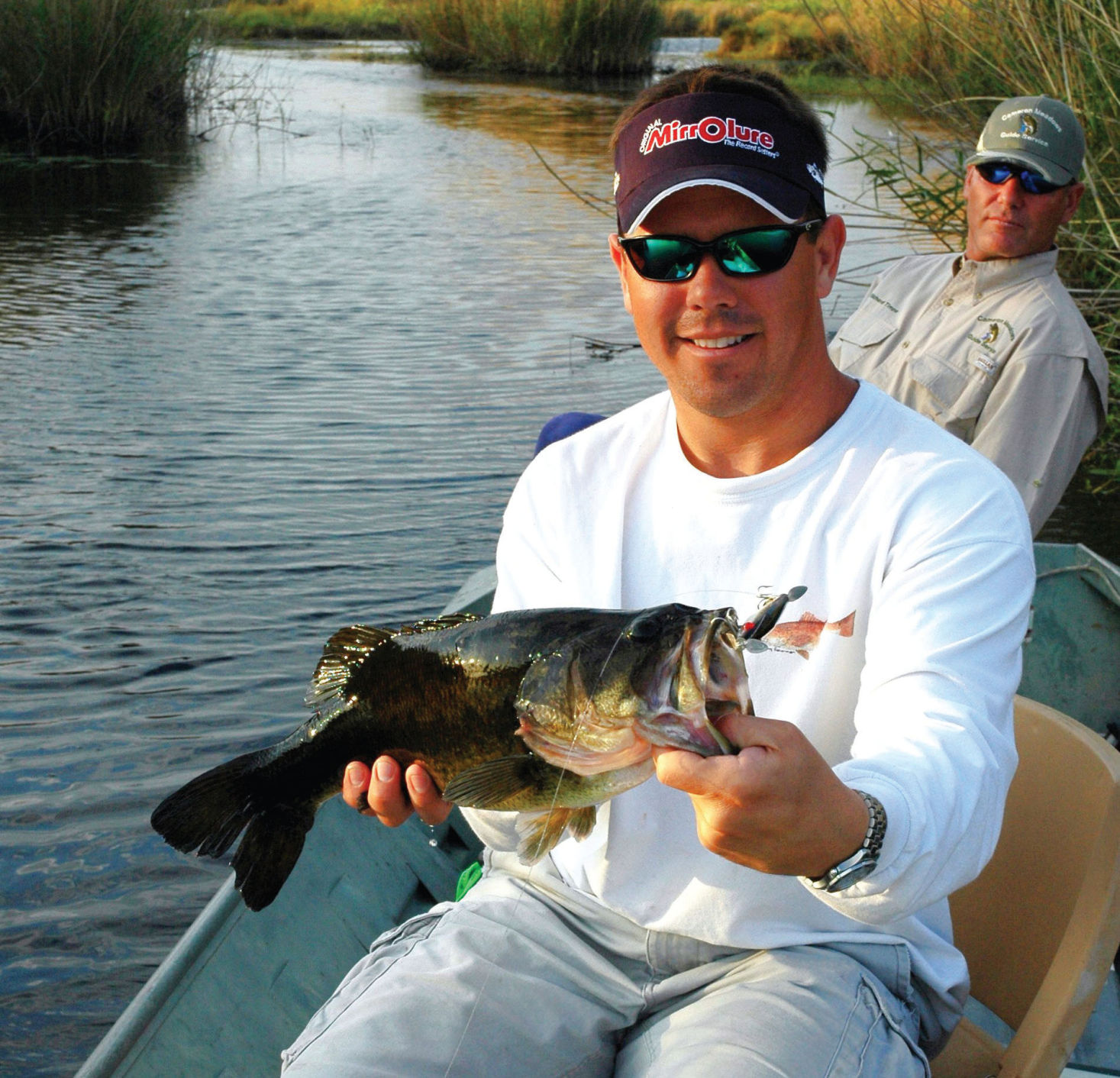
Bubba’s still standing
March 26, 2015BREAKING: Grand jury clears Terrebonne deputy in 2014 shooting death of teen
March 26, 2015Of course, nobody likes to fish during a hurricane, something every south Louisiana person knows very well, but strong winds typically affect fishermen more than fish. Winds can make casting and boat control more difficult and fishermen uncomfortable. Therefore, when winds whip the marshes or turn Lake Salvador into a white-capping froth, many Cajun sportsmen run for cover. However, they might run from the bass.
Beneath the water, often hunkered down in thick weeds, bass don’t know how fast the wind blows. However, they do know that they can find abundant food and oxygen along wind-beaten shorelines. Winds move plankton-rich water. Shad, mullets and other baitfish feed on plankton as it stacks up along windward shorelines. Currents might also disorient baitfish and break up schools, making them easy pickings for ravenous bass.
Breakers pounding shorelines or ripping through thick weed beds may also dislodge a smorgasbord of morsels from their protective lairs. Waves might dislodge crawfish or other creatures hiding in mud or grass. Waves smashing through fallen trees hurl prey into open water or toss critters clinging to concrete riprap. In addition, winds can knock insects, lizards, frogs, snakes or other creatures into the water where huge gaping mouths of hungry bass wait to devour them. Wave action also aerates water by dissolving oxygen, giving bass everything they need along a windward shoreline.
Winds can also cause or change currents. Winds can even overcome times. The tide chart might say a falling tide, but a strong south wind blows water up from the Gulf of Mexico, flooding the marshes. On the other hand, a brutal north wind could turn marsh ponds to mudflats by pushing water toward the Gulf. Whether pushed by wind or tide, bass often face into the current watching for food to flow to them. This does not necessarily mean that they face into the wind. Water crashing against a shoreline “mushrooms” like a bullet as it bounces off hard objects.
Wind also serves as excellent natural camouflage for anglers, lures, lines, boats and associated equipment. On calm days, fish can see shadows or outlines silhouetted against a bright sky. When these images fall on a placid surface in clear water, they can easily spook wise lunkers.
“Wind breaks up the surface,”
said Peter Thliveros, a bass pro. “Flat calm conditions make fish spooky and aware of everything going on above and below the water. It’s some of the most difficult conditions to catch fish. If wind breaks the surface of the water and makes it difficult for fish to see, it puts them in a less defensive posture.”
Wind also hides anglers by creating natural noise from waves lapping against the shore, logs and rocks or just by blowing across a surface. Bass grow accustomed to hearing breaking waves. In effect, wind noise “jams” manmade noise in the way that military forces send signals to disrupt enemy sensors. Similarly, waves pounding against rocks or shorelines mute human sounds.
The more natural noise, the less likely a bass might detect unnatural noises, such as electric motor propellers whirring in still water. Unnatural noises can easily spook bass, particularly in heavily pressured lakes. Masked by a brisk breeze, anglers can sneak up on largemouths undetected and make accurate, stealthy lure placements at shore range.
“It’s impossible to keep from making noise in a boat,” said Alton Jones, a former Bassmaster Classic champion. “On a windy day, bass don’t care as much about noise. On a calm, sunny day, almost any small noise might spook a bass. Wind makes bass less aware of human presence. They act like totally different creatures when they don’t think anyone is around. People need to learn how to use wind to their advantage and not their detriment. Wind is almost like wearing camouflage for fishing.”
In the right place, anglers can use quiet wind power to drift across shallow grassy flats, using the trolling motor only sparingly for directional control. Run the boat upwind to the far shoreline, raise the motor and drift quietly. After hitting the windward side of the pond or flat, crank the outboard, run through already fished waters to avoid disturbing bass and return to the far shoreline for another drift. If planned correctly, anglers can zigzag across highly productive waters with little effort almost undetected.
In open marshes without anything to block the breezes, winds sometimes blow too strongly to allow good drifting. If so, toss out a sea sock, a wet version of a windsock, to catch water and create drag that slows boat drift. Anglers can also drag a simple five-gallon bucket behind a boat to slow the momentum. Some anglers drag chains to reduce speed so they can probe a honey hole more thoroughly.
“In big shallow flats, drifting with the wind is a very effective way to find fish,” Thliveros said. “Wind might cause grass to lay down in a certain direction. That makes little channels or troughs in the grass. Bass get into those pockets. Hit those pockets and channels with spinnerbaits.”
Big spinnerbaits often out-fish other lures on windy days. Blades create plenty of vibration in the water to compete with the natural noise generated by wave action. In stained water, throw baits with big round Colorado blades to create more bass-attracting thumping action. When fishing weedy areas, throw slim willow-leaf blades, which generally cut through vegetation better. Willow-leaf blades might also work better in clearer water.
“The harder wind blows, the better bass bite spinnerbaits,” Jones said. “One of my favorite techniques is to run a spinnerbait as fast as possible along a steep rocky bank. I use a 1/2-or 3/4-ounce willow-leaf spinnerbait because I want speed without lift. I like white and chartreuse with double No. 4 and No. 3 gold willow-leaf blades. I reel fast and steady. When bass hit, they practically knock the rod out of my hands.”
Wind also creates constrictions around points, logjams, sandbars or narrow marshy cuts that force fish into small areas. Often, bass hide on the lee side of wind-blown chokepoints to ambush anything currents might drive past their noses. As morsels appear, bass dash out, gobble a few helpings and retreat to slack water to conserve energy.
“I like to fish places where points narrow the water,” Jones said. “That constricts where fish are going to be and forces current through that chokepoint. That’s a natural gathering place for fish. Sometimes fish get on the upper end of a choke-point, on the backside or right off the point. That’s a good place to throw Carolina rigs or crankbaits. In crank-baits, I like chartreuse with a blue back, and white with a chartreuse back. I’m partial to medium-running Fat Free Shads in citrus or chartreuse with a blue back.”
When bass bust shad around points, fast-burning lipless crankbaits, such as Rat-L-Traps produce excellent results. Run crankbaits around the ends of points, parallel to structure or through constricted water. Position the boat into the wind if possible and run baits with the current to mimic baitfish drifting with wind-driven water.
Certainly, strong winds can make things more difficult for anglers. For that reason, many top bass anglers often find themselves alone on winds-swept shorelines. They might also find themselves with a livewell full offish!
‘Wind breaks up the surface. Flat calm conditions make fish spooky and aware of everything going on above and below the water. It’s some of the most difficult conditions to catch fish.’
Peter Thliveros
Professional bass fisherman
Gerald Swindle, a professional bass angler from Warrior, Ala., lands a bass he caught on a jig with a plastic creature trailer. Despite what many fishermen say, fishing on calm days create an atmosphere where fish are more aware of their surroundings and are less likely to bite.







